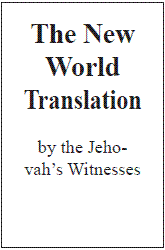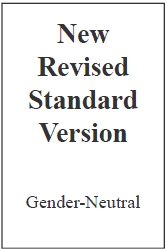|
|
|
Which translation of the Bible should we use?
There are two main categories, kinds or styles of Bibles
Why are there so many versions today? Are all versions reliable? Truly, there are only two kinds of translations. For example, some are a direct quote from the early copies. These are called “literal translations” or “word for word”, meaning they directly quote every word God said. Others do not directly quote what God actually said, but instead give an interpretation, explanation, amplification, paraphrase, restatement, or suppression of the words He actually used or spoke. These Bibles are truly an “interpretation”, not a translation, of the word of God. This always adds too and takes away from the words of God. Below are some examples of both kinds of Bibles.
A. Literal Bibles (Direct Quote)
. New American Standard (used for this study) . King James, New King James . New English Standard, Etc.
B. Interpretations (Not a Direct Quote)
. Amplified & Commentary Bibles . Simplified Bibles . Gender-Neutral Bibles, Etc.
Note: The purpose of the lists is to give you a basic and fundamental sense of the two main styles of Bibles, not to present a complete or comprehensive list of Bibles for each category. You must do your own homework. Even more, beware! Some Bibles, like the Revised Standard Version (RSV), were complete literal translations when first introduced. But their successors/replacements are not. For example, the New Revised Standard Version (NRSV), is not a complete literal version. Instead it is a so called “gender-neutral” Bible. As explained on the next page, Gender-neutral Bibles are worse than a paraphrase because they do not translate masculine words, and instead replace them with no-gender replacements. Therefore they are not gender-neutral, but instead are truly “feminine-favored” or “pervert-preferred” Bibles. These translators despise the masculine gender. They refuse to even translate it! Shocking!
How to tell the difference between the two
(A) What is the stated intent of the translators? At the front, many Bibles include the goals of the translators or commissioning group. Some say that their Bible is an “Amplified Bible.” This means that they are explaining it or interpreting it in addition to or in place of translating it. Others say their purpose was to stick to the original text, word for word, as closely as possible and if possible. So read about the goals and intent of the translators.
(B) What is their un-stated intent? People have differing belief systems which may or may not influence their translation work. So, if you can, consider their affiliations or beliefs. Because of the mistaken belief of certain translators, some Bibles have more of a bias than others which changes the original meaning of certain passages. For example:
The New World Translation

This Bible was translated by the sect called the “Jehovah’s Witnesses.” They mistakenly believe that the Son of God is not Deity, and for this reason they do not worship Him. They do not understand how the Son of God can also be God, like His Father. So because of their mistaken belief, they have intentionally mis-translated certain passages to hide, remove, and suppress the true Deity of God’s Son. For example,
(a) In John 1:1, most Bibles reveal that God’s Son “was God”, with a capital ‘G’. But the New World Translation says, “was a god”, with a little ‘g’ and with an added ‘a’. This non-capitalization indicates that they do not believe in Jesus’ Deity, but instead believe that He is a creature whom God created.
(b) In Hebrews 1:8, most Bibles reveal that God the Father talks about His Son being God, saying, “But about the Son He [the Father] says, Thy throne, O God [Son], will last for ever and ever”. But the Jehovah’s Witnesses’ Bible has restated that verse in such a way as to hide or remove the Deity that the Father Himself has attributed to His own Son. For this reason, the Jehovah’s Witness New World Translation should be avoided altogether, because it misrepresents the main character in the Bible, God’s Son, Jesus Christ.
Note: In my Bible Study on the Divine Regulations of Christian Worship, I prove the Deity of Jesus Christ with many Scriptures, and I answer the main objections of the Jehovah’s Witnesses.
Gender Neutral Bibles [A.K.A. Gender-Bender or Masculine Emasculated Bibles!]
Another obvious example of a biased, and also a non-literal, Bible is what is deceptively called a “Gender Neutral” Bible. In the 1990’s, publishers, translators, and religious groups first began to make these kinds of Bibles. They should instead be called “masculine neutered” or “emasculated” Bibles, since they remove the male gender from almost all passages, excepting for now most passages about the Father and the Son (which are masculine terms). Why do they do this? It is because certain worshipers want a genderless God, a genderless religion. Some do not want to offend the female gender, the feminists or the world, since some of these people do not want a masculine deity. If these false worshipers get their way entirely, they will take away the gender of our Father, our Son, and the Holy Spirit, whom the Scriptures call a “He” (Jn 14:26). So these are “pervert preferred” Bibles or “feminine favored” Bibles.
The specific problems which these Bibles introduce are detailed in The Bible Study on True Worshipers, “for Such People the Father Seeks to Be His Worshipers” (Jn 4:23).
Note: The Book of Mormon is not even in the same class as the Bible because it is not the Bible. It is a totally different story which was fabricated and composed by Joseph Smith in 1830. He claimed to use a seer stone to create it. He was a sorcerer. This book is utterly false.
Conclusion
Some Bibles accurately communicate the very words that God spoke, and some do not. The ones which add more words or meaning to the passages, explaining them in greater detail than what is in the early copies, or restating whole sentences or thoughts, are interpretations, not translations. They reflect more of what men think, not what God actually said. They are not directly quoting God’s words, and are at best paraphrases. Yet they typically suppress or add to the word of God by this style of ‘translation’. They should not be used, for example, as a legal document, will, or testament because of the additions and subtractions of the translators (no legal document, such as a person’s will, should be added to or paraphrased, or restated in different words or thoughts, especially God’s will).
Any Bible, whether it’s a word for word translation or one that is an interpretation, can put footnotes and commentaries from men near the words of God. Therefore, these notes and commentaries need to be carefully tested as to whether they have any merit or value. It seems that the best Bible to have and use is one that is understandable to the reader, and accurately translated; a word for word translation (a literal translation, one that actually quotes the word of God). A more accurate Bible, a potentially more accurate faith of the one reading it. If you want to be a stable follower of God, then you must be aware of the pitfalls of certain Bibles, especially the one(s) which misrepresent who Jesus is or His gospel. Is the Bible reliable? Yes, by far it is reliable. But some translations are obviously better than others. BACK TO INTRO HOME PAGE Website & Bible study content Copyright 2001, © Patrick David Yanello, All rights reserved. |
 The
New Revised Standard Version
(NRSV), is a masculine neutered, gender-bender Bible. This version,
and others like it, of which there are several (like the NIV-I, with
“I” meaning “inclusive”, yet we know that it
truly is “exclusive”), these should be avoided altogether
since they do not translate male terms. You cannot trust the
thousands and thousands of pronouns in these Bibles. Some even
mistranslate gender specific prophecies in the Old Testament about
the Son of man, the Christ, blurring or blotting out the meaning
altogether.
The
New Revised Standard Version
(NRSV), is a masculine neutered, gender-bender Bible. This version,
and others like it, of which there are several (like the NIV-I, with
“I” meaning “inclusive”, yet we know that it
truly is “exclusive”), these should be avoided altogether
since they do not translate male terms. You cannot trust the
thousands and thousands of pronouns in these Bibles. Some even
mistranslate gender specific prophecies in the Old Testament about
the Son of man, the Christ, blurring or blotting out the meaning
altogether.